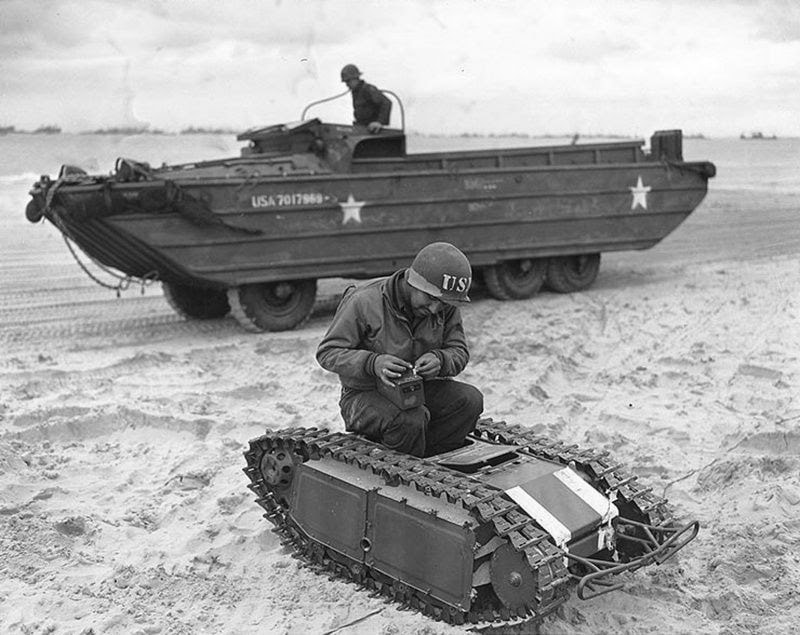 Two DUKWs carrying a P-38. (Photo: Worldwarphotos.info)
Two DUKWs carrying a P-38. (Photo: Worldwarphotos.info)
DUKW, which comes from the model-naming terminology used by GMC, is an acronym for the fact that it was “D,” designed in 1942, “U,” a utility vehicle that was “K,” all-wheel drive, with “W,” two rear axles. Soldiers, who had nicknames for everything, first called them Ducks. The vehicle was developed in only 38 days through a collaboration between yacht designers Sparkman & Stephens and General Motors. It had a 104 horsepower Chevy engine which was able to reach 50 mph on land and 6 mph on water. They were 31 feet long, 8 feet wide, and 7 feet high. A quarter of the 21,000+ DUKWs that were manufactured between 1942 and 1945 had .50 caliber Browning machine guns ring-mounted to them.
 A DUKW at Utah Beach. In front, a soldier inspects a German Goliath tracked mine. (Photo: world-war-2.wikia.org)
A DUKW at Utah Beach. In front, a soldier inspects a German Goliath tracked mine. (Photo: world-war-2.wikia.org) The Army was not impressed with its design at first, and rejected them. However, when a Coast Guard patrol craft ran aground on a sand bar during a storm near Provincetown, Massachusetts, a prototype DUKW that was being tested nearby was able to save the patrol craft’s crew. The Army, now aware of the craft’s versatility, changed its mind. By March 1943, they were successfully being used in Guadalcanal in the South Pacific. They were also used to great effect in Operation Husky, the 1943 invasion of Sicily. In addition to their normal transport duties, DUKWs were used as naval ambulances and for providing fire support to landing troops.
Opinions on DUKWs changed after their failure during the D-Day Invasion, where all but one of the vehicles being used to haul howitzers to Omaha Beach sank shortly after debarking from their carriers. This wasn’t a failure of the vehicle so much as a failure of command to understand the DUKW’s limitations. In good weather, DUKWs perform well. In bad weather, especially in high waves and when loaded with heavy cargo such as howitzers, they are not seaworthy.
 The specially modified DUKW with an extension ladder used at Pointe du Hoc (Photo: Mikesresearch.com)
The specially modified DUKW with an extension ladder used at Pointe du Hoc (Photo: Mikesresearch.com)
Most DUKWs were decommissioned after World War II. A few hundred went to the Korean War and to Vietnam, while others were distributed to police and civilian search-and-rescue units, where they continue to serve.


